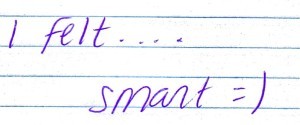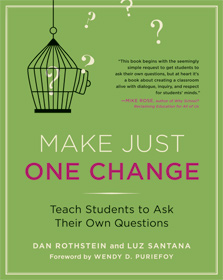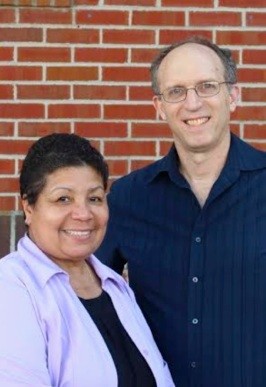
The title of a feature story on the cover of the 9/15/13 New York Times magazine asked this question: “Can Emotional Intelligence Be Taught?” When I got to Jennifer Kahn’s thoughtful article on “social and emotional learning” (SEL), I found a different question on the title page of the piece itself: “If everybody knows that test scores and grades aren’t the keys to success, how do we teach and measure, the things that are?”
Two questions. One closed and one open. Each one setting the stage for what follows. This skill of asking questions, and to ask different kinds of questions, both open and closed, reflects well upon the journalistic expertise of the article’s author and editors who made the editorial decision to lead with these two questions. It is no small matter to come up with these two questions and set the agenda for what we need to learn, to grasp and to understand. There’s serious cognition at work when deciding which questions to emphasize. Journalists become experts at asking questions by…asking questions, lots of them, and then through trial and error, they learn how to ask better questions.
Effectively asking questions is a cognitive ability that needs to be developed over time. But, there is something more than cognition at work when we actually figure what is the right question we need to ask (or, too often, the question we should have asked!). Is there, perhaps, a connection between the ability to ask questions and social and emotional learning? And, to follow in the sequence of the Times article, starting with a closed-ended question and moving to an open-ended question: If we know that questions tap into deep thoughts and emotions and open up new pathways of thinking and feeling, what kind of social and emotional growth can we expect to see when students learn how to ask their own questions?
In twenty years of work teaching skills for self-advocacy in communities all around the country and after several years learning from thousands of classroom teachers in a wide range of settings, we’ve become convinced that there is indeed a strong connection and we can observe significant changes in feelings and emotions that emerge. We began our work with low-income parents in Lawrence, MA, who first named the problem of “not knowing what to ask” as a major obstacle to their feeling comfortable and confident enough to even go to their children’s schools and meet with their teachers. Their absence from the schools was not because they didn’t care about their children’s education. They did, deeply. But, it was a feeling that kept them away, feeling unsure of themselves, feeling overwhelmed and a bit intimidated by professionals who seemed to know much more than they did even when they put out welcome mats for parents, family members and guardians.
But, when the parents did learn to ask their own questions, that feeling, and many other obstacles, including income, level of education, language differences, got pushed aside. Their new feeling, sparked by knowing how to ask their own questions, was clearly articulated by a resident of a homeless shelter in Louisville, KY: “I’ll not settle for hearing my child’s ‘doing ok.’ I’ll do whatever it takes to get the information I need.” A parent in Paterson, NJ also discovered that her new ability to ask questions made her feel more calm and prepared when she went into a meeting with the principal after hearing that her son’s teacher had wrongly disciplined her child: “I put my ‘irateness’ aside, went in there and could talk with the principal and get done what needed to be done.”
She, and others, taught us that there is something to the act of thinking in questions and even of writing questions down that is akin to SEL methods for encouraging students to take a deep breath or count to seven. Spending time thinking about what she wanted to ask, instead of just going in and yelling at the principal, allowed her to compose herself through the act of composing questions. Is there a connection between composing oneself and composing questions? There is a connection, a strong one. We began to hear not only from parents but also from many educators that the process we developed for learning to ask questions – the Question Formulation Technique – actually takes on another role as an anger management tool. We had never set out to design it for that purpose, but it had become one.
What is true for the parents has been demonstrated over and over again for their children. In the past two years, ever since Harvard Education Press published our book, Make Just One Change: Teach Students to Ask Their Own Questions, we’ve heard stories from teachers working in urban, suburban, rural, public and private schools, that there is a very strong affective change that takes place when students learn how to ask their own questions.
They become more engaged, sit up straighter, listen to each other’s questions, participate more confidently, figure out ways to work together and feel a sense of themselves as “problem-solvers.” And, it all happens without an overly complex program, nor does it require months of training and thousands of dollars. A student in a remedial summer-school program in Boston who was at risk of being held back, reflected on what he had learned during the five weeks in summer school. “I’m getting good at this question thing…and it makes me feel smart.”
Teachers report that by using a rigorous process for asking questions, that deploys four simple rules for producing them and then provides clear steps for improving and prioritizing their questions, their students develop new divergent, convergent and metacognitive thinking abilities. But, the teachers see more than just cognitive changes. Their students name, when asked to reflect on what they learned and how they learned it, that they feel better equipped to pause before talking and think through their questions. The feel better able to listen to their peers because they are hearing questions rather than statements, opinions or declarations.
There’s something about the particular nature of questions as a form of speech, thinking and communications that is simply different and makes possible new pathways of thinking and, as we all know, new pathways to a wide range of feelings. At the East Brooklyn Community High School in New York City, a school where many students are overage or undercredit, teachers across different disciplines have found that teaching students to ask their own questions serves not only as a critical thinking strategy, but also as an effective “classroom management” strategy that gets students participating, working together, regulating themselves and listening to others.
Questions are powerful. Questions can not only can change thinking patterns, they can lead to deeper and deeper layers of feelings. Questions are an essential tool for therapists and psychoanalysts, who, like journalists, lawyers, entrepreneurs, scientists and scholars, simply could not do their work without being able to ask good questions.
Teachers as much as if not more than any other professionals, certainly understand the power of questions. The Times article actually commences in a kindergarten in Oakland, CA, with the teacher asking questions of his students to try to get them to reflect on their feelings and to think in new ways. This pattern, teachers asking questions of students to get them to pause, think, reflect, analyze and explore, will continue throughout their formal education, all the way through higher education.
We should change the unidirectional nature of that interaction that begins in kindergarten and continues every year after. We should change the pattern of the teacher asking questions of the students as the primary means to get them to grow, intellectually and emotionally. We should take that deceptively simple and powerful tool that teachers are using, the skill of asking questions, and provide more opportunities for students to learn to learn to do it for themselves, to learn to ask their own questions.
When students learn to ask their own questions, they gain a new sense of self-efficacy, of “getting good at the question thing.” They ‘feel smart’, joining together emotion and cognition in one very insightful articulation of the connection between cognitive and emotional growth that offers a concrete way to act on the question appearing on the magazine’s cover: Can emotional intelligence be taught?
Learning to ask questions is a simple strategy, far less complex and comprehensive (and far less expensive) than the SEL programs described in the article. And, it can be embedded into any classroom in any community. Perhaps, the next article on social and emotional learning will lead off not with questions from the journalist or teacher, but with questions from students.




Dear Dan, An excellent commentary in followup to the article to the New York Times Magazine piece. As an “effect modifier”, or social advocate, I have altered the way I approach a room full of grassroots/community oriented people since reading your book, Make Just One Change. I do find that at the end of the meeting, the more questions about messaging and strategy are encouraged the more buy-in, and on going participation in a given project. Although I have had a lot of experience working with groups of people, and know how to draw the “quieter ones” out, the added dimensionality of listening to how they ask questions helps me to remember when to ease up and let the community dynamic flow rather than remain in full “consultant” mode.